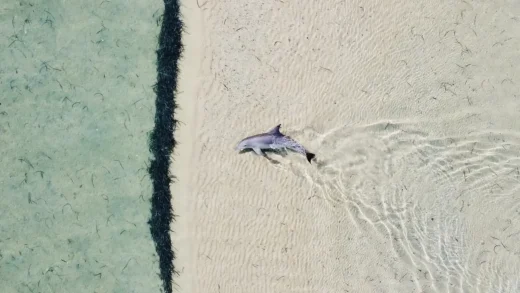
In the realm of visual storytelling, where images and motion coalesce to captivate audiences, there lies an often-underestimated element that possesses the power to immerse viewers in a realm beyond the mere visual. It is the unsung hero that breathes life into animations, creating a symphony of emotions and igniting a sensory journey that transcends the limitations of sight alone. This intangible force, known by many names but commonly referred to as sound design, encompasses the art of crafting and manipulating auditory elements to evoke profound reactions within the minds and hearts of spectators.
Sound design, in essence, can be likened to a master conductor, orchestrating a harmonious collaboration between music, sound effects, and ambient noise. It infuses each stroke of animation with a personality, a soul that resonates with viewers on a subconscious level. Through subtle nuances and grand crescendos, sound design navigates the audience through a multi-dimensional narrative, weaving emotions and moods into the very fabric of the motion graphic experience.
Just as a painted canvas and expert lighting combine to imbue a scene with a particular ambiance, sound design adds a layer of richness and depth to the audiovisual tapestry. The ethereal whispers of wind, the percussive beats of footsteps, and the thunderous booms of explosions collaborate to form an intricate sonic landscape that harmonizes perfectly with the visual storytelling. This auditory symphony seizes the viewer’s attention and plunges them into a realm where imagination is intensified, and immersion becomes an inevitability.
The Role of Sound Design in Animation
Sound design plays a crucial and dynamic role in the world of animation, contributing to the overall sensory experience and captivating the audience’s attention. Through strategic and thoughtful implementation of sounds, animators are able to create an immersive and engaging environment that enhances the storytelling and brings the animated characters and worlds to life.
Enhancing Emotional Connection
One of the key roles of sound design in animation is to establish a strong emotional connection between the audience and the animated characters. By carefully selecting and manipulating various sound elements, such as dialogue, music, and sound effects, animators have the power to evoke a wide range of emotions, including joy, excitement, fear, or sadness. These emotional cues help the audience to better understand and empathize with the characters, making their journey more relatable and memorable.
Creating a Sense of Realism
Sound design also plays a vital role in creating a sense of realism within the animated world. By incorporating realistic and believable sounds, such as footsteps, rustling leaves, or car engines, animators can make the audience feel like they are part of the animated environment. This attention to detail not only adds depth and authenticity to the animation but also enhances the overall viewing experience.
- Immersive Soundscapes: Sound designers skillfully create intricate soundscapes by adding layers of sound effects, ambient noises, and background music, which transport the audience into the animation’s world.
- Highlighting Actions and Movements: By accentuating the actions and movements of characters through well-designed sound effects, animators enrich the visual experience and make it more engaging.
- Setting the Scene: Sound design helps in setting the scene and creating a specific atmosphere or mood. Whether it’s a bustling city or a serene countryside, the soundscape sets the tone and enhances the overall storytelling.
Ultimately, sound design is an essential component of animation that elevates the overall audio experience, captivating the audience’s senses, and bringing the animated world to life. Through its ability to enhance emotional connections and create a sense of realism, sound design adds depth and richness to the animation, making it a truly immersive and memorable experience for viewers.
Creating Immersive Storytelling through Sound Effects
Delivering an impactful and engaging storytelling experience is a crucial aspect of any animation. While visual elements grab the audience’s attention, the strategic use of sound effects plays a pivotal role in creating an immersive atmosphere and transporting viewers into the world of the animation.
By employing a wide array of auditory tools, animators have the power to enhance the storytelling process. Sound effects serve as a means to convey emotions, set the tone, emphasize key moments, and capture the essence of the characters and their surroundings. They add depth and realism to the animation, making it more relatable and captivating for the audience.
Think about the sound of a gust of wind as a character walks through a desolate landscape, the subtle creaking of a door as it slowly opens to reveal a hidden room, or the dramatic swell of music as the hero embarks on a daring journey. These sound effects, carefully chosen and implemented, have the ability to evoke emotions, build tension, and immerse the audience in the narrative.
Furthermore, sound effects provide valuable audio cues that aid in understanding the story. They can guide the viewer’s attention, highlight important plot elements, and create a seamless transition between different scenes. By harnessing the power of sound, animators can guide the audience’s emotions and provide a complete sensory experience.
Creating a truly immersive storytelling experience through sound effects requires meticulous planning and attention to detail. Sound designers work closely with animators to understand the nuances of the narrative and the emotions that need to be conveyed. They carefully select and create sounds that align with the animation’s style, theme, and character development, ensuring every auditory element enhances the overall impact of the story.
In conclusion, sound effects play a vital role in enhancing the storytelling experience in animation. They have a profound impact on the audience, immersing them in the virtual world and helping them connect with the characters and events on a deeper level. By carefully crafting and utilizing sound effects, animators can create a truly captivating and memorable audiovisual journey for the viewers.
The Importance of Music in Setting the Mood and Enhancing Emotions
Music plays a crucial role in creating the desired atmosphere and intensifying the feelings portrayed in animated content. By harnessing the power of various sound elements, such as melody, rhythm, and instrumentation, animation can evoke a range of emotions and immerse viewers into the story.
Through carefully chosen music, animators can effectively establish the mood of a scene, whether it be joyful, suspenseful, or melancholic. The harmonious blend of melodies and instruments can instantly transport the audience to different settings, allowing them to emotionally connect with the visual narrative.
Additionally, music helps enhance and intensify the emotions experienced by viewers. It acts as a catalyst, heightening the impact of dramatic moments, injecting energy into action sequences, or tugging at heartstrings during poignant scenes. The skillful use of musical cues and motifs can reinforce the intended emotional response, making the animated content more memorable and impactful.
Furthermore, music has the ability to strengthen the viewer’s engagement and overall audio experience within animated works. The right musical choices can establish a sense of familiarity, as recurring themes or motifs throughout the animation create aural associations with specific characters, places, or events. This helps in building a cohesive story world and enhances the overall enjoyment and immersion of the audience.
Overall, the thoughtful selection and implementation of music in animation greatly contribute to the success of the audiovisual experience. By setting the mood and enhancing emotions, music elevates the storytelling power of animated content, making it more captivating, relatable, and impactful for viewers of all ages.
Utilizing Dialogues and Voice Acting for Character Development
Exploring the impact of dialogues and voice acting in animation plays a pivotal role in shaping the development of characters. By leveraging the creative potential of verbal exchanges and the artistry of voice actors, animators can forge a deeper connection between the audience and the on-screen personalities. Through the tactical use of dialogue and voice acting, animators can grant characters their distinctive traits, unearthing their values, emotions, and identities that make them relatable and engaging.
Unveiling Character Traits through Dialogue
The manner in which characters engage in conversations provides a window into their personality traits and motivations. Through their words, characters can express their intellect, wit, or even vulnerability, allowing the audience to grasp their essence on a deeper level. Moreover, dialogue enables animators to establish character roles, such as the hero, the villain, or comedic relief, by crafting distinct speech patterns, vocabulary, and tones for each character. Whether it is a quick-witted exchange, a heartfelt monologue, or a humorous banter, dialogues shape the character’s perception and impact how they are perceived by the audience.
The Artistry of Voice Acting
Voice acting brings life to animated characters, adding another layer of depth and emotion to their portrayal. Skilled voice actors use their vocal range, intonation, accents, and timing to breathe life into the animated personas. Through their captivating performances, voice actors have the power to amplify the impact of dialogues, making them feel authentic and relatable. A well-executed voice acting performance can evoke a range of emotions and enhance the audience’s connection with the characters’ experiences, making them memorable and iconic.
In conclusion, the utilization of dialogues and voice acting is paramount in character development within the realm of animation. Through carefully constructed dialogues, animators reveal the diverse traits and motivations of characters, while voice acting infuses these personalities with life, inviting the audience to form a profound connection. Thus, this intricate combination ultimately contributes to the overall immersive audio experience in animated films and series.
Adding Depth and Realism with Ambient and Background Sounds
Expanding the immersive experience of animated content goes beyond just visuals. One crucial element that greatly contributes to the overall impact is the intricate use of ambient and background sounds. These audio elements play a significant role in enhancing the realism and depth of the animation, enabling viewers to fully engage and emotionally connect with the content.
By skillfully incorporating a variety of ambient and background sounds, animators create a multi-layered auditory landscape that complements the visuals and adds a sense of authenticity to the on-screen environment. Through the clever placement and manipulation of sounds, animators can establish a convincing and believable atmosphere, whether it be a bustling city street, a serene nature scene, or a lively animated world.
The versatility of ambient and background sounds allows animators to craft a realistic sonic environment that breathes life into the animated world. From the subtle rustling of leaves to the distant sound of traffic, these carefully selected audio elements add depth and texture to the storytelling, immersing the audience and enhancing their overall experience.
Moreover, ambient and background sounds serve as powerful tools in guiding the audience’s attention and guiding the narrative. By strategically placing sounds within the audio mix, animators can direct the viewers’ focus to specific actions or characters, enhancing the storytelling and creating a more engaging and captivating experience.
Effective sound design goes beyond simple background noise. It involves meticulous attention to detail and a deep understanding of the storytelling goals. By incorporating ambient and background sounds thoughtfully, animators can evoke emotions, create tension, build suspense, and even emphasize subtle nuances in the animation, improving viewers’ overall perception and connection to the content.
In conclusion, the inclusion of ambient and background sounds in animation significantly contributes to the overall depth and realism of the audiovisual experience. Through careful consideration and skillful implementation, these audio elements enhance the audience’s immersion, improve storytelling, and create a more engaging and captivating animated world.
Enhancing the Audio Experience with Foley and Sound Mixing
Exploring the Art of Sound in Animation
- Elevating the auditory dimension through Foley
- The creative process behind sound mixing
- Creating a harmonious blend of sound and visuals
- The impact of immersive audio techniques
- Enhancing storytelling with intricate sound design
Within the realm of animation, the audio experience holds an extraordinary power in captivating and immersing viewers. Through the skillful utilization of Foley and sound mixing techniques, animators have the opportunity to transport audiences into unique auditory realms that complement the visuals on screen.
Foley, often referred to as the art of sound effects, is the practice of recreating or enhancing sounds in post-production. By incorporating real-world sounds to animate the actions happening on-screen, artists can greatly enhance the authenticity and depth of the storytelling. Every footstep, rustle, or impact takes on a life of its own, enriching the viewing experience for the audience.
Sound mixing, on the other hand, focuses on the intricate balance and manipulation of different audio elements within a scene. It involves adjusting the volume, timing, and placement of sound effects, dialogue, and music to create a harmonious blend that complements the visuals and emotions portrayed. Through careful selection and layering of these elements, sound mixers can guide the audience’s attention and evoke specific emotions in a scene, enhancing the overall impact of the storytelling.
This tandem of Foley and sound mixing is instrumental in achieving a seamless integration of sound and visuals, resulting in a multilayered and engrossing audio experience. When executed skillfully, it transports viewers beyond the realm of mere animation, creating a sense of immersion and emotional connection that can only be attained through the combined magic of sound and imagery.
Modern advancements in audio technology have also paved the way for the implementation of immersive audio techniques, further enriching the audio experience. Through the use of spatial sound and surround sound systems, animators have the ability to create an all-encompassing sonic environment, adding an additional layer of depth and realism to the animation. When applied thoughtfully, these techniques have the potential to transport viewers directly into the heart of the story, as if they are experiencing it firsthand.
Ultimately, the art of sound design in animation not only complements the visuals but also serves as a powerful tool for storytelling. By meticulously crafting and manipulating various audio elements, animators can evoke emotions, establish atmosphere, and deepen the audience’s connection to the narrative. Foley and sound mixing, in particular, play a pivotal role in elevating the audio experience, breathing life into animated worlds and leaving a lasting impression on the viewer.
The Impact of Sound Design on Audience Engagement and Enjoyment
When it comes to captivating an audience and ensuring their full immersion in an animated experience, sound design plays a pivotal role. The way sound elements are carefully crafted and incorporated into animations can greatly influence the level of engagement and enjoyment experienced by the viewers.
Sound design goes beyond simply adding background music or sound effects to a scene. It involves a meticulous process of selecting and manipulating sounds to create a rich and cohesive auditory environment that complements the visuals. By doing so, sound design enhances the overall storytelling and emotional impact of the animation, creating a more immersive and engaging experience for the audience.
- Audience immersion: Sound design helps transport the audience into the animated world by creating a realistic and convincing auditory experience. Skillful use of sound effects, such as footsteps, rustling leaves, or even subtle ambient sounds, can make the viewers feel like they are fully present in the animated environment.
- Emotional connection: The choice of background music, sound effects, and even the absence of sound in certain moments can evoke specific emotions in the audience. Whether it’s a suspenseful scene with intense music, a joyful moment accompanied by uplifting melodies, or a sad moment enhanced by somber tones, sound design plays a crucial role in establishing an emotional connection between the viewers and the animated characters.
- Enhanced storytelling: Sound design can effectively convey important narrative elements and enhance the storytelling aspect of animations. Through the use of sound, nuances, and cues, the audience can gather additional information about the characters, their surroundings, and the overall context of the story. Subtle audio cues can also serve as foreshadowing or build anticipation, further enriching the narrative experience.
- Engaged attention: Well-crafted sound design captures and maintains the attention of the audience throughout the animation. By introducing changes in the sound, such as variations in volume, intensity, or spatial placement, sound design keeps the viewers engaged and prevents their attention from waning. This sustained engagement contributes to the overall enjoyment of the animation.
- Imagination stimulation: The creative use of sound design can stimulate the imagination of the audience, allowing them to fill in the gaps and create a more immersive experience in their minds. For example, a well-designed sound effect or an atmospheric background score can transport viewers to fantastical worlds, triggering their imagination and making the animation more memorable.
In conclusion, sound design has a profound impact on audience engagement and enjoyment in animation. By skillfully incorporating sound elements into animations, creators are able to immerse the audience in the animated world, establish emotional connections, enhance storytelling, maintain attention, and stimulate imagination. The importance of sound design should not be underestimated, as it greatly contributes to the overall audio-visual experience and leaves a lasting impression on the viewers.



